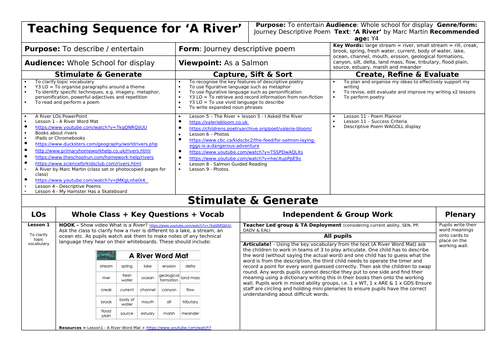

















This is a 3-week unit of work which focuses upon writing a story poem about salmon on their run up stream where they need to avoid bears and eagles. I always teach this during my Raging Rivers unit as it fits so well in this topic. The text driver is a beautifully drawn book called ‘A River’ by Marc Martin. This unit focuses upon the key features of descriptive poetry such as; metaphors, personification, expanded noun phrases powerful adjectives and vivid language. It also exposes the pupils to a variety of different poets looking at their style and how they have used these key features.
The end written piece is an opportunity to generate a great piece of writing as there is a well-structured plan to support your less able pupils. My class love this unit as they are engaged by the story of how brave the salmon are though some of the class always choose to write a poem where their salmon does not make it! I have included all the resources including worksheets, WAGOLL and displays so you can start using this straight away. The learning objectives for this unit are;
Stimulate & Generate
• To find the meaning of words
• To organise paragraphs around a theme
• To identify specific techniques, e.g. imagery, metaphor, personification, powerful adjectives and repetition
• To read and perform a poem
Capture, Sift and Sort
• To recognise the key features of descriptive poetry
• To use figurative language such as metaphor
• To use figurative language such as personification
• To retrieve and record information from non-fiction
• To use vivid language to describe
• To write expanded noun phrases
Create, Refine and Evaluate
• To plan and organise my ideas to effectively support my writing
• To revise, edit evaluate and improve my writing x2 lessons
• To perform poetry
This unit of work uses the 3-stage planning process of:
• Stimulate and Generate
• Capture, Sift and Sort
• Create, Refine and Evaluate
Stimulate and Generate = This usually starts with a hook to interest the class where the class realise who they are going to write for so they have a clear purpose and audience. Activities can include reading excellent model texts, drama or researching more about the author or the content of the book.
Capture, Sift and Sort = This is the part of the unit where pupils look at key features, practise skills they will need in order to complete the final piece or new learning for objectives they have not learnt yet.
Create, Refine and Evaluate = This is where you bring all you have learnt together and plan the final piece before you write it and then edit it to improve the piece. This can include self, peer or teacher led reviewing.
Something went wrong, please try again later.
Great planning and resourcing overall but the link for the Guided Reading text 'For salmon, laying Eggs is a dangerous adventure' for lesson 8 no longer works which makes the lesson redundant.
Fantastic planning - thank you so much! My class are loving it so far. The only issue is that the salmon guided reading text is no longer available online... do you by any chance have a copy of this anywhere to send to me? I can't find much online! I would be so grateful as teaching the lesson on Monday :)
There is such a wealth of resources here . I think my class will love it and I am excited to teach it. Thank you so much for sharing.
Report this resourceto let us know if it violates our terms and conditions.
Our customer service team will review your report and will be in touch.